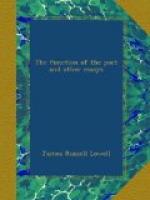But this partiality in a biographer, though to be allowed and even commended as a quickener of insight, should not be strong enough to warp his mind from its judicial level. While we think that Mr. Forster is mainly right in his estimate of Swift’s character, and altogether so in insisting on trying him by documentary rather than hearsay evidence, it is equally true that he is sometimes betrayed into overestimates, and into positive statement, where favorable inference would have been wiser. Now and then his exaggeration is merely amusing, as where he tells us that Swift, “as early as in his first two years after quitting Dublin, was accomplished in French,” the only authority for such a statement being a letter of recommendation from Temple saying that he “had some French.” Such compulsory testimonials are not on their voir dire any more than epitaphs. So, in speaking of Betty Jones, with whom in 1689 Swift had a flirtation that alarmed his mother, Mr. Forster assumes that she “was an educated girl” on the sole ground, so far as appears, of “her mother and Swift’s being cousins.” Swift, to be sure, thirty years later, on receiving some letters from his old sweetheart, “suspects them to be counterfeit” because “she spells like a kitchen-maid,” and this, perhaps, may be Mr. Forster’s authority. But, as the letters were genuine, the inference should have been the other way. The “letters to Eliza,” by the way, which Swift in 1699 directs Winder, his successor at Kilroot, to burn, were doubtless those addressed to Betty Jones. Mr. Forster does not notice this; but that Swift should have preserved them, or copies of them, is of some consequence, as tending to show that they were mere exercises in composition, thus confirming what he says in the remarkable letter to Kendall, written in 1692, when he was already off with the old love and on with a new.




